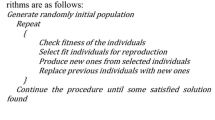Abstract
Telecommunication technology advances in the past decade have brought networking to another level in terms of reliability and link speeds. However, existing transmission control protocols do not provide satisfactory performance due to their inefficient congestion control mechanisms. In this paper, we propose a new congestion control scheme to provide Quality of Service provisioning while ensuring bandwidth efficiency. Based on the evolutionary minority game (EMG) model, the proposed algorithm adaptively controls the packet transmission to converge a desirable network equilibrium. For the efficient network management, the proposed EMG approach is dynamic and flexible that can adaptively respond to current network conditions. A simulation shows that our proposed scheme can approximate an optimized solution while ensuring a well-balanced network performance under widely different network environments.





Similar content being viewed by others
References
Mahapatra, A., Anand, K., & Agrawal, D. P. (2006). QoS and energy aware routing for real time traffic in wireless sensor networks. Computer Communications, 29(4), 437–445.
Tao, L., & Yu, F. (2011). A novel congestion detection and avoidance algorithm for multiple class of traffic in sensor network. In IEEE international conference on cyber technology in automation, control, and intelligent systems (pp. 72–77).
Shaii, A. Q., Ismail, R., Jais, J. & Manan, J. (2008). Congestion avoidance: Network based schemes solution. In International symposium on information technology (ITSim 2008) (pp. 1–4).
Kutsuna, H., & Fujita, S. (2011). A fair and efficient congestion avoidance scheme based on the minority game. Journal of Information Processing Systems, 7(3), 531–542.
Shang, L. H. (2007). Self-organized evolutionary minority game on networks. In IEEE international conference on control and automation (ICCA 2007) (pp. 1885–1889).
Araujo, R. M. & Lamb, L. C. (2004). Towards understanding the role of learning models in the dynamics of the minority game. In IEEE international conference on tools with artificial intelligence (ICTAI 2004) (pp. 727–731).
Leino, J. (2003). Applications of game theory in ad hoc networks. Master’s Thesis, Helisnki University of Technology.
ManChon, U., & Li, Z. (2010). Public goods game simulator with reinforcement learning agents. In ICMLA’2010 (pp. 43–49).
Tanaka-Yamawaki, M. & Tokuoka, S. (2006). Minority game as a model for the artificial financial markets. In IEEE congress on evolutionary computation (CEC 2006) (pp. 2157–2162).
Sysi-Aho, M., Saramäki, J., & Kaski, K. (2005). Invisible hand effect in an evolutionary minority game model. Physica A, 347, 639–652.
Mähönen, P., & Petrova, M. (2008). Minority game for cognitive radios: Cooperating without cooperation. Physical Communication, 1, 94–102.
Kim, S., & Kim, S. (2007). An online buffer management algorithm for QoS-sensitive multimedia networks. ETRI Journal, 29(5), 685–687.
Menasche, D. S., Figueiredo, D. R., & de Souzae, Silva E. (2005). An evolutionary game-theoretic approach to congestion control. Performance Evaluation, 62(1–4), 295–312.
Altman, E., El-Azouzi, R., Hayel, Y. & Tembine, H. (2008). An evolutionary game approach for the design of congestion control protocols in wireless networks. In Physicomnet workshop (pp. 1–6).
Kim, S., & Varshney, P. K. (2005). An adaptive bandwidth allocation algorithm for QoS guaranteed multimedia networks. Computer Communications, 28, 1959–1969.
Author information
Authors and Affiliations
Corresponding author
Rights and permissions
About this article
Cite this article
Kim, S. Evolutionary Minority Game Model for Congestion Control Scheme. Wireless Pers Commun 78, 1199–1210 (2014). https://doi.org/10.1007/s11277-014-1812-1
Published:
Issue Date:
DOI: https://doi.org/10.1007/s11277-014-1812-1




